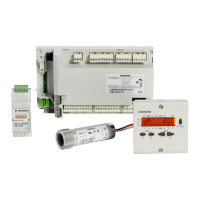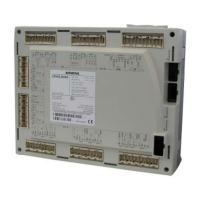46/213
Building Technologies Basic documentation LMV37.4... CC1P7546en
HVAC Products 6 Basic unit 01.12.2009
6.5 Program sequence
The program sequence is shown in the form of sequence diagrams (refer to section Fuel
trains). Using a number of parameters, the program sequence can be adapted to the re-
spective application.
6.5.1 Time parameters
Using a number of time parameters, the time characteristics of the different types of fuel
trains can be matched to the requirements of the respective application.
No. Parameter
211 Fan ramp up time
212 Max. time to low-fire
213 Waiting time home run
214 Max. time to start release
217
Max. waiting time for detecting a detector or pressure switch signal (e.g. home
run, preignition)
225 Gas: Prepurge time
226 Gas: Preignition time
227 Gas: Safety time 1 (TSA1)
229
Gas: Time to respond to pressure faults within safety time 1 (TSA1) and safety
time 2 (TSA2)
230 Gas: Interval 1
231 Gas: Safety time 2 (TSA2)
232 Gas: Interval 2
233 Gas: Afterburn time
234 Gas: Postpurge time (no extraneous light test)
242 Gas: Valve proving evacuation time
243 Gas: Valve proving time test atmospheric pressure
244 Gas: Valve proving filling time
245 Gas: Valve proving time test gas pressure
246 Gas: Gas shortage waiting time
248 Gas: Postpurge time (t3) (interruption if load controller (LR) ON)
265 Oil: Prepurge time
266 Oil: Preignition time
267 Oil: Safety time 1 (TSA1)
269
Oil: Time to respond to pressure faults within safety time 1 (TSA1) and safety
time 2 (TSA2)
270 Oil: Interval 1
271 Oil: Safety time 2 (TSA2)
272 Oil: Interval 2
273 Oil: Afterburn time
274 Oil: Postpurge time (no extraneous light test)
284 Oil: Postpurge time (t3) (interruption if load controller (LR) ON)
Caution!
The OEM or the heating engineer is responsible for making certain that the
times conform to the standards covering the respective type of plant.

